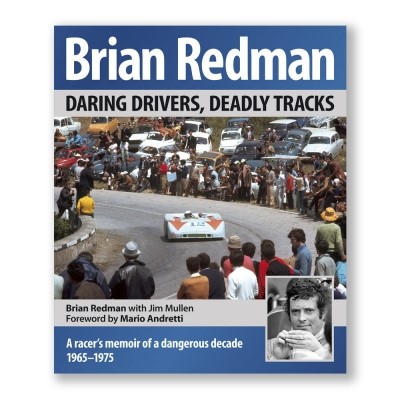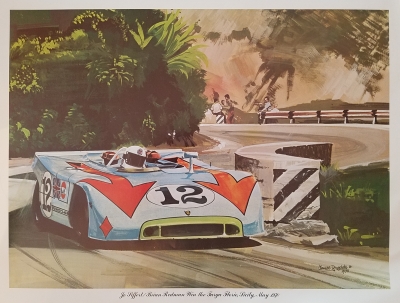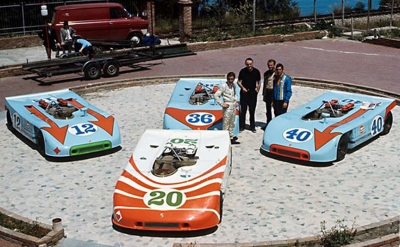1970 Targa Florio Winning Porsche 908/03
-1970 Targa Florio Winning Porsche 908/03-
In 1970 Brian and his Swiss team mate Jo - Seppi- Siffert were a part of the John Wyer Engineering team of purpose buit, lightweight, Porche 908/03. Each car had a similar paint scheme with individual identifying marks.
The 1970 winning car has what has become one of the most iconic liveries in racing and is featured on the cover of Brians book available here.

This painting was commissioned by Brian in 1970, shortly after his victory, from James Dugdale, an artist who was from the same part of Lancashire as Brian.
The painting below was commissioned by Brian and is only available here.

17" x 21" poster
Very few available.
These are new old stock and have been stored at Brian Redman's Intercontinental Events office. Items can be signed by Brian if requested for no additional charge.
Free shipping within the USA.

The Targa Florio was in 1970 the oldest motor race in the world, even older than the Isle of Man TT and the Indianapolis 500. First run in 1906, it was run on narrow public mountain roads that went up and down, and twisted and turned around the Sicilian countryside. From 1951 to 1977 it was run on the 45 mile Piccolo (Italian for small) course- by far the longest circuit on the 1970 World Sportscar Championship calendar.
It was one of, if not the last of the genuine road races still run in the world.
The Piccolo course went through 4 to 5 towns in the island of Sicily. The circuit was extremely demanding and very difficult to learn- over the 45 mile course, there were between 800 and 900 corners- 16 to 20 corners for every mile, and the circuit had about 2,000 feet of elevation change- twice that of the Nurburgring. There was also a number of straights joined together by a number of fast corners at the top of the circuit that measured out to about 6 miles- but the circuit was so twisty and had so many corners, average speeds never went past even 80 mph (128 km/h)- which in racing terms is very slow.
The circuit was also very dangerous- although the roads and streets were closed off to the public for the race (but not for practice and test sessions- this caused all sorts of problems) the circuit was identical to every day civilian use, so it had no safety features of any kind and a crash often meant tumbling down a mountain slope or when in a town, crashing into a stone building, trees, and even groups of spectators. Although the Targa was a race where over its history very few people died in relation to other races like the Mille Miglia and the Carrera Panamericana, it was still a risky affair.



